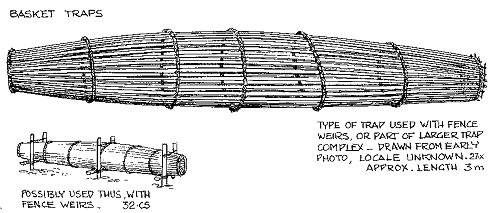

 |
 |
|
First Nations peoples made many different kinds of traps for catching salmon. These traps
were used in rivers and streams, as well as at places along the coast, where salmon gathered in
large numbers. The type and style of trap used depended on the water conditions it was used in.
Usually, traps were cylinder or box shaped, and were often used in conjunction with a weir. This combination worked well because the weir would stop the
salmon from going up stream and directed them into the traps. The fishermen, who usually set
the traps at night, would come by in the morning and retrieve their trapped catch. It was very
easy to catch large numbers of salmon using a trap and weir. 
A basket trap often used with a weir, or as part of a larger trap structure. Images © Hilary Stewart. Indian Fishing: Early Methods on the Northwest Coast. p. 114. The opening of a trap often narrowed from quite wide to very small. Fish easily found their way in but had greater difficulty trying to find their way back out. Fishermen used clubs when taking the fish from the traps. Some traps even had hatch doors on top so that the trap could be emptied without moving it. Salmon traps were first made out of wood, such as cedar or hemlock, but today it is more likely to find wire traps being used.

A river trap used in shallow fast moving water. Images © Hilary Stewart. Indian Fishing: Early Methods on the Northwest Coast. p. 114.
Using traps and weirs together was a common practice until weirs were banned. Today, traps are used to help protect salmon. Biologists and stream technicians put traps into rivers and streams to catch salmon they want to check on. Once caught, the salmon are harmlessly held in the traps so that they can be measured and tagged. The information the scientists collect can tell them if the salmon's habitat is healthy or harmful to the salmon. |